Why Is Missouri a Habitat for Zebra Swallowtail Butterflies?
The Zebra Swallowtail Butterfly (Eurytides marcellus) in Missouri is identified by its striking black and white striped wings and elongated hindwing tails marked with red and blue spots, ranging in wingspan from 6.4 to 10.4 cm. This species mainly relies on pawpaw trees (Asimina triloba) for larval sustenance, thriving in riparian zones, deciduous forests, and open woodlands.
Lifecycle stages include egg, larva, pupa, and adult, with key behaviors dictated by seasonal changes. Conservation efforts in Missouri focus on habitat preservation and community engagement to mitigate threats from habitat loss and climate change.
Further insights reveal more on their ecological role and observation tips.
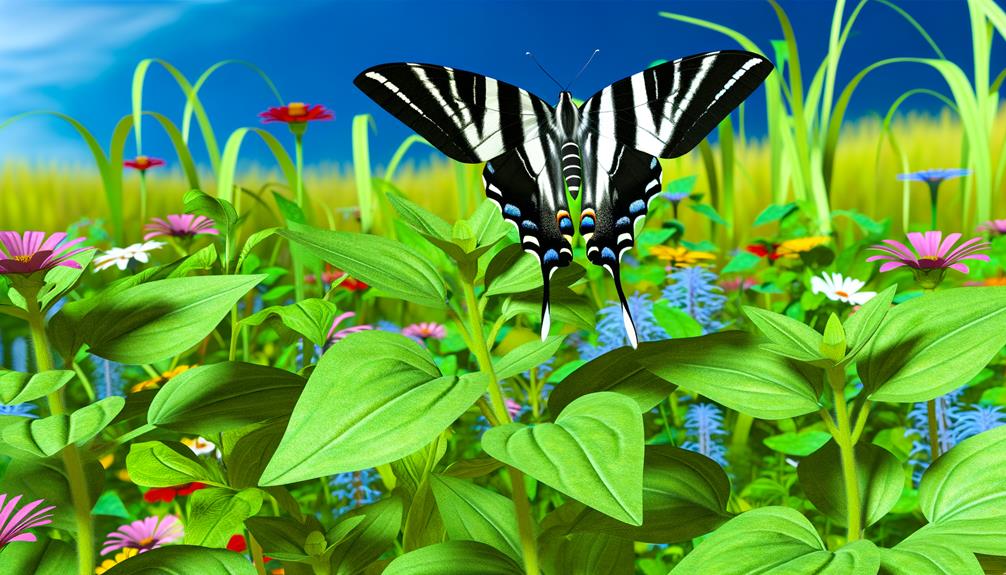
Key Takeaways
- Zebra Swallowtail Butterflies in Missouri thrive in riparian zones, deciduous forests, and open woodlands near pawpaw trees.
- The larvae exclusively feed on pawpaw leaves, making the availability of these trees crucial for their survival.
- Adult butterflies are recognizable by their black and white striped wings and elongated tails tipped with red and blue spots.
- Conservation efforts in Missouri focus on habitat restoration, pawpaw tree propagation, and community engagement programs.
Identification
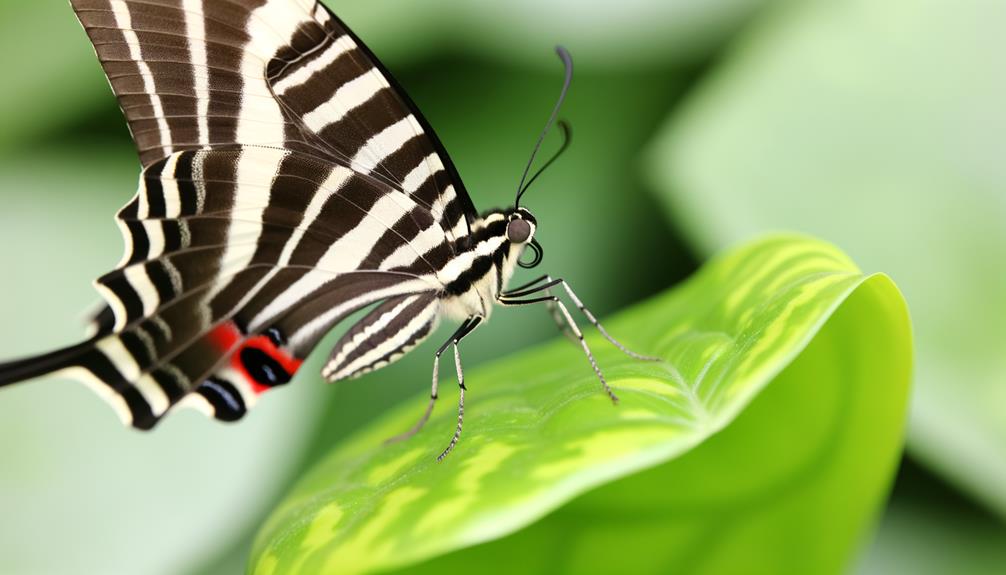
The Zebra Swallowtail Butterfly (Eurytides marcellus) can be identified by its distinct black and white striped wings, which resemble a zebra's pattern, along with elongated tails on its hindwings.
The forewings are triangular, featuring bold black stripes against a white or pale green background. The hindwings possess an extended tail resembling a swallow's, tipped with red and blue spots near the base.
The wingspan ranges from 6.4 to 10.4 centimeters, varying by season and sex. The body is similarly striped, aiding in camouflage among foliage.
Significantly, the spring morphs are smaller and paler, while summer morphs are larger and more vibrant. These features collectively enable the precise identification of this species in its natural habitat, ensuring enthusiasts can distinguish it effortlessly.
Life Cycle
Understanding the identification characteristics of the Zebra Swallowtail Butterfly lays the foundation for exploring its intricate life cycle, which encompasses distinct stages including egg, larva, pupa, and adult.
The female deposits eggs singularly on the leaves of host plants, primarily the pawpaw tree.
Larvae emerge and undergo several instars, characterized by specific molting phases. These caterpillars exhibit a distinctive green coloration with yellow and black stripes.
Upon reaching maturity, the larvae form a chrysalis, entering the pupal stage. This transformative phase, lasting approximately two weeks, culminates in the emergence of the adult butterfly.
The adult Zebra Swallowtail, identifiable by its striking black and white-striped wings, engages in reproduction, hence perpetuating the life cycle.
Habitat
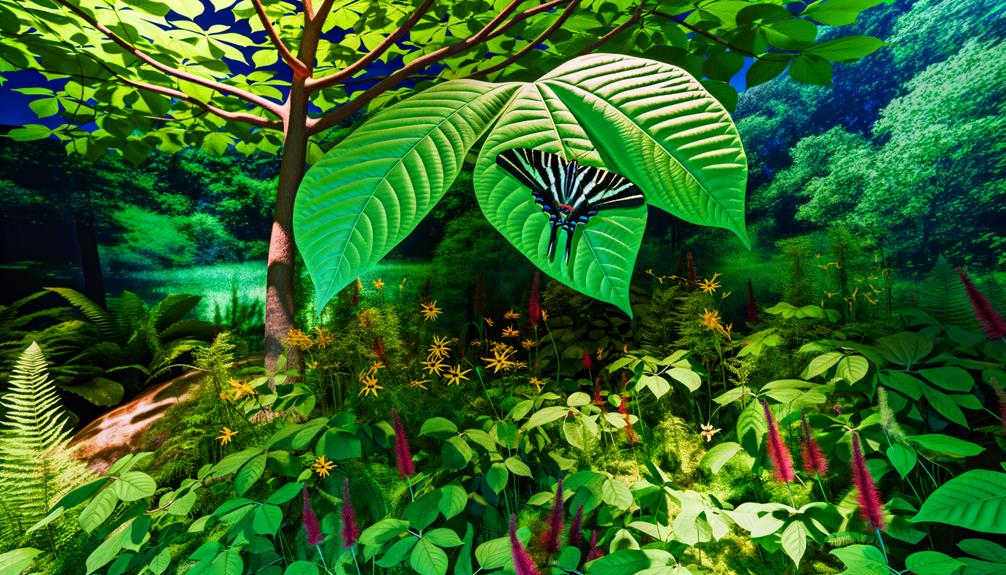
Inhabiting diverse environments across Missouri, the Zebra Swallowtail Butterfly primarily thrives in areas where pawpaw trees, their primary larval host plants, are abundant. These butterflies favor riparian zones, deciduous forests, and open woodlands. They are often found near streams and rivers, which provide the necessary moisture for the pawpaw trees. This habitat preference guarantees ideal conditions for larval development and adult butterfly activities such as mating and feeding.
| Habitat Type | Key Features | Importance |
|---|---|---|
| Riparian Zones | Moist soil, water sources | Essential for pawpaw growth |
| Deciduous Forests | Dense canopy, varied flora | Supports diverse life stages |
| Open Woodlands | Mixed vegetation | Facilitates movement and sunlight exposure |
| Stream Vicinity | High humidity, water access | Critical for maintaining host plant health |
This intricate relationship between the Zebra Swallowtail and its habitat underscores the species' ecological specificity and adaptability.
Diet
Beyond their specialized habitat requirements, Zebra Swallowtail Butterflies exhibit a diet that intricately ties their survival to specific floral resources and host plants. These butterflies rely mainly on pawpaw trees as host plants for their larvae, making their distribution closely linked to the presence of these trees. Adult Zebra Swallowtails feed on nectar from various flowers, but they show a preference for blooms that provide ample energy for their active flight patterns. Like other swallowtail butterflies in Ontario, their survival depends on the availability of suitable habitats and sufficient food sources throughout their life cycle.
Larvae primarily feed on pawpaw trees (Asimina triloba), consuming the leaves for essential nutrients. This obligate relationship underscores the butterfly's reliance on pawpaw for development.
Adult butterflies, conversely, derive sustenance from nectar sources including milkweed, redbud, and blackberry flowers. They exhibit a preference for high-energy nectar to fuel their vigorous flight patterns.
The selection of these floral resources is critical, as it guarantees the availability of carbohydrates required for mating and oviposition.
Fundamentally, the dietary needs of Zebra Swallowtail Butterflies are finely tuned to their ecological niche, facilitating their life cycle and reproductive success.
Role in Ecosystem
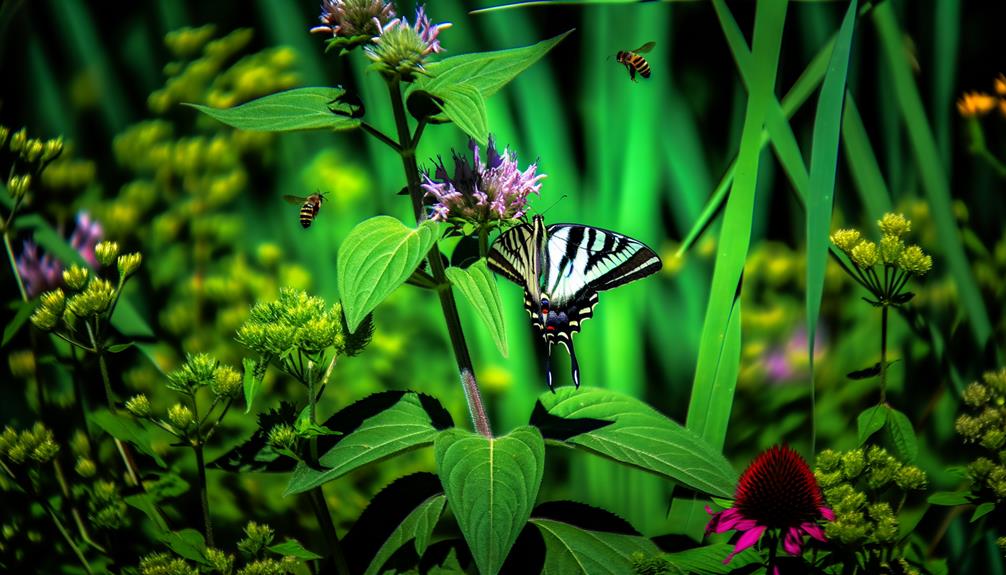
Zebra Swallowtail Butterflies play an essential role in their ecosystem by acting as pollinators for a variety of flowering plants, consequently facilitating cross-pollination and contributing to plant genetic diversity.
These butterflies interact with numerous plant species, ensuring the transfer of pollen. Their presence supports the reproductive success of plants, which in turn sustains other wildlife forms.
Significantly, they also serve as a food source for predators, thereby maintaining the ecological balance.
Key contributions include:
- Pollination: Enhancing genetic variability of flowering plants.
- Food Source: Serving as prey for birds and other predators.
- Indicator Species: Reflecting environmental health and biodiversity.
- Habitat Formation: Promoting growth of plant communities that provide habitats for various organisms.
Seasonal Behavior
Throughout the year, the Zebra Swallowtail Butterfly exhibits distinct seasonal behaviors that are closely tied to temperature changes and the availability of host plants like the pawpaw tree.
In spring, adults emerge and engage in mating flights, often seen fluttering around forest edges and open fields.
As temperatures rise in summer, multiple broods are produced, with larvae feeding voraciously on young pawpaw leaves. Activity peaks during this period, marked by increased nectar foraging.
By late summer and early fall, the butterfly population declines as adults complete their life cycle.
Overwintering occurs in the pupal stage, with chrysalides entering diapause to survive colder months, resuming development once favorable conditions return in spring.
Host Plants
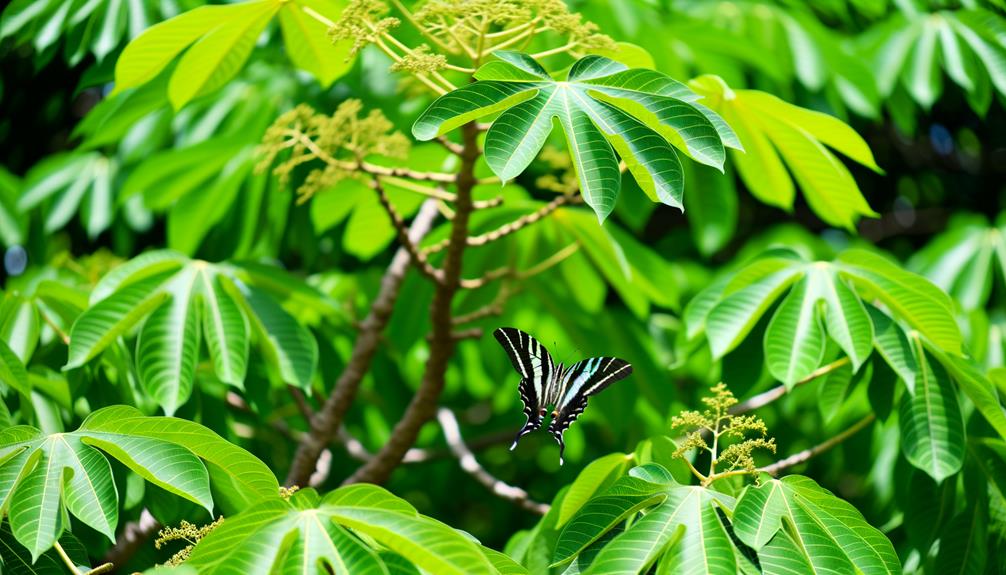
A vital aspect of the Zebra Swallowtail Butterfly's life cycle is its reliance on the pawpaw tree (Asimina triloba) as the primary host plant for its larvae. The larvae exclusively feed on pawpaw leaves, which contain toxic compounds that provide a defense mechanism against predators. This strict dependency on pawpaw trees shapes the butterfly's habitat preferences and influences its distribution.
Key points about the host plant relationship include:
- Larval Dependency: Zebra Swallowtail larvae feed solely on pawpaw leaves.
- Chemical Defense: Pawpaw leaves contain acetogenins, which deter predators.
- Habitat Selection: Butterflies are found in habitats where pawpaw trees thrive.
- Reproductive Success: Availability of pawpaw trees directly impacts larval survival and butterfly population growth.
This specialized relationship underpins the species' ecological niche.
Threats
The Zebra Swallowtail Butterfly faces several significant threats that jeopardize its survival, primarily stemming from habitat loss, climate change, and pesticide use. Habitat fragmentation disrupts the availability of pawpaw plants, essential for larval development. Climate change alters temperature and precipitation patterns, impacting the butterfly's life cycle and migration. Pesticide use, particularly in agricultural areas, reduces adult and larval populations through direct toxicity and food source contamination.
| Threat | Impact on Butterfly | Consequence |
|---|---|---|
| Habitat Loss | Reduced pawpaw availability | Lower larval survival rates |
| Climate Change | Altered life cycle timing | Disrupted reproductive success |
| Pesticide Use | Direct toxicity | Decreased adult populations |
These threats collectively contribute to the declining numbers and fragmented populations of the Zebra Swallowtail Butterfly in Missouri.
Conservation Efforts
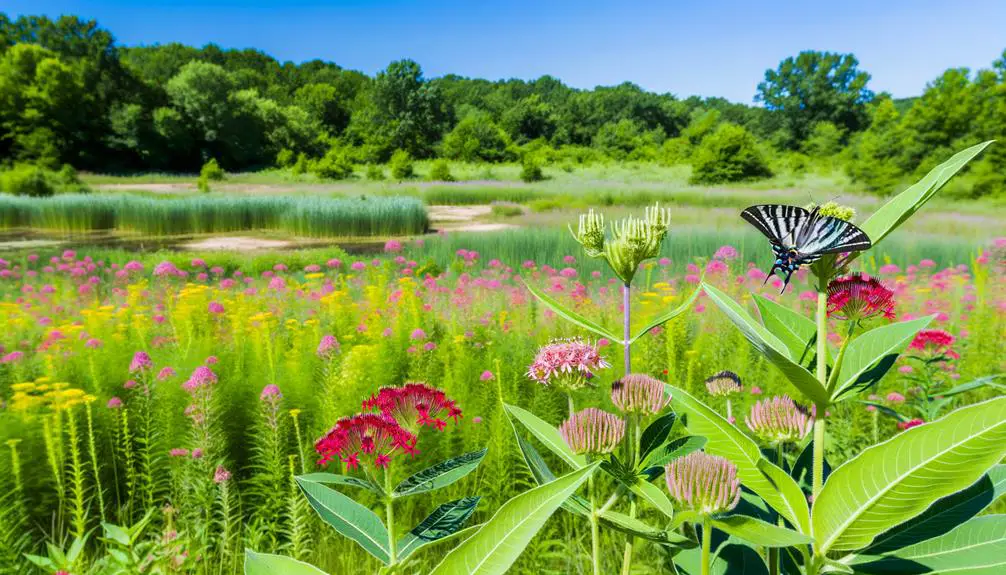
Conservation efforts for the Zebra Swallowtail Butterfly in Missouri focus on habitat preservation initiatives, which aim to protect and restore vital pawpaw tree populations.
Additionally, community engagement programs play an important role in raising awareness and fostering local stewardship.
Addressing threats through targeted mitigation strategies guarantees a thorough approach to safeguarding this species' future.
Habitat Preservation Initiatives
To guarantee the survival of the Zebra Swallowtail Butterfly in Missouri, targeted habitat preservation initiatives have been implemented, focusing on maintaining and restoring critical environments such as riparian woodlands and pawpaw groves. These efforts encompass a variety of strategic actions:
- Habitat Restoration: Rehabilitating degraded riparian woodlands to enhance ecological integrity.
- Pawpaw Cultivation: Propagating and planting pawpaw trees, the butterfly's host plant, in suitable habitats.
- Monitoring Programs: Implementing regular surveys to track butterfly populations and habitat health.
- Invasive Species Control: Eradicating non-native species that threaten native flora and fauna.
Community Engagement Programs
Engaging local communities through educational workshops, citizen science projects, and volunteer-driven habitat restoration activities is crucial for the conservation of the Zebra Swallowtail Butterfly in Missouri. These initiatives foster an informed public, empowering individuals to participate actively in conservation efforts.
Educational workshops provide critical knowledge on butterfly ecology and habitat requirements. Citizen science projects enable residents to contribute to data collection, enhancing scientific understanding of population dynamics.
Volunteer-driven habitat restoration focuses on planting pawpaw trees (Asimina triloba), the butterfly's larval host plant, and removing invasive species. These community-oriented programs create synergistic effects, amplifying conservation outcomes while promoting ecological stewardship.
Involvement of local communities guarantees sustained efforts, fostering a collective sense of responsibility towards preserving the Zebra Swallowtail Butterfly.
Threats and Mitigation Strategies
Building on the foundation of community engagement programs, addressing the threats facing the Zebra Swallowtail Butterfly in Missouri requires a multifaceted approach to conservation that targets habitat loss, climate change, and pesticide use.
Effective conservation efforts should incorporate:
- Habitat Restoration: Rehabilitate and expand pawpaw tree populations, essential for Zebra Swallowtail larval development.
- Climate Adaptation Strategies: Implement measures to buffer habitats against climate variability, ensuring sustainable microclimates.
- Pesticide Regulation: Promote the use of butterfly-safe pesticides and restrict harmful chemicals that disrupt their lifecycle.
- Public Awareness Campaigns: Increase public knowledge on the importance of butterfly conservation through educational initiatives and volunteer programs.
These strategies collectively aim to protect and sustain the Zebra Swallowtail Butterfly population in Missouri.
Observation Tips
When observing the Zebra Swallowtail Butterfly in Missouri, selecting prime viewing locations such as riverbanks and moist woodlands is essential.
The best times for observation are during the early morning and late afternoon when these butterflies are most active and feeding.
Utilizing binoculars and field guides can enhance the accuracy and enjoyment of your observations.
Prime Viewing Locations
To maximize the likelihood of encountering the Zebra Swallowtail Butterfly in Missouri, focus your observations in areas with abundant pawpaw trees, particularly in riparian zones and forest edges. These specific habitats provide the necessary resources and environmental conditions that support their lifecycle.
For ideal viewing, consider the following prime locations:
- Riparian Zones: These areas along rivers and streams offer moisture and pawpaw trees, essential for Zebra Swallowtails.
- Forest Edges: The changing zones between forests and open areas are perfect due to the availability of sunlight and host plants.
- Conservation Areas: Protected lands, such as state parks, often have undisturbed habitats conducive to butterfly populations.
- Botanical Gardens: Managed gardens that cultivate native flora, including pawpaw trees, can be excellent observation sites.
Best Observation Times
Ideal observation times for the Zebra Swallowtail Butterfly in Missouri are during the spring and summer months, particularly from late April through August. These periods align with the butterfly's life cycle stages, maximizing sightings during peak activity.
Best viewing is typically in the late morning to early afternoon when temperatures are warmer and butterflies are most active. Observers should focus on open, sunny areas near pawpaw trees (Asimina triloba), which are vital for the butterfly's larval stage.
Monitoring weather patterns is important; clear, calm days enhance visibility and butterfly activity.
Employing binoculars with a close-focus feature can aid in detailed observation without disturbing their natural behavior, ensuring a rewarding and minimally intrusive experience.
Conclusion
The zebra swallowtail butterfly, a striking species in Missouri, signifies the splendor of natural systems. Sustaining biodiversity, these butterflies serve as essential pollinators.
However, habitat destruction and climate change challenge their continued existence. Conservation efforts, including habitat restoration and planting host plants, are vital.
Collective commitment can combat these challenges, ensuring the zebra swallowtail's survival. Protecting this pollinator promotes ecological balance, preserving the intricate interplay of flora and fauna.
The zebra swallowtail's future hinges on human action.





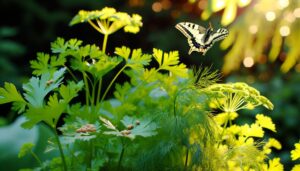

Good https://is.gd/tpjNyL